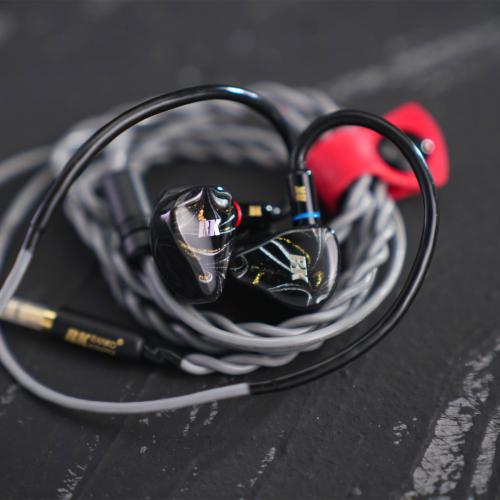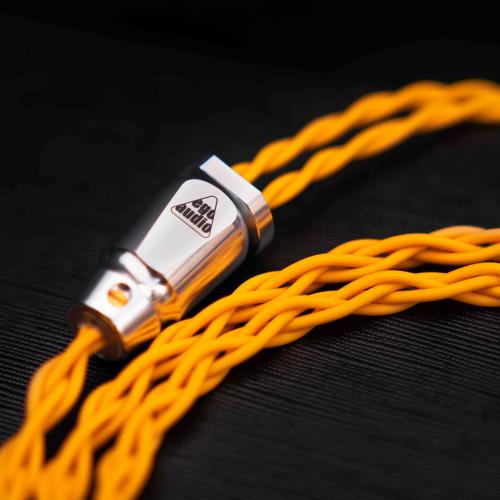
Sound Impressions: RUF-100 Ag vs. Average cable
Let’s do some A/B tests, comparing RUF-100 and an ordinary C-to-C cable. As for the source, we’ll use Muse HiFi M4 Player, Samsung Galaxy Note 10 Plus, Cayin N8 player, and a laptop PC. Testing IEMs are Rhapsodio Infinity 2, Subtonic Storm, BQEYZ Wind, and Kinera Verdandi.
RUF-100 brings a noticeable upgrade throughout the spectrum—first, the bass. The color tone of the bass gets noticeably bolder and thicker (not the actual thickness but the color). There’s quite a difference in the density too as the bass feels more concentrated and tighter. The reverbs are not affected yet the strike and decay from the bass have gotten more clean and agile. The improvement gets more noticeable when listening to music with speed or fast tempo, as the low-end dynamics are more tightly controlled.
Vocals gain a similar improvement as the bass. The density and tightness of the mid-range have increased, making the vocals more concentrated. Though RUF-100 does more to the vocals than it did with the bass. The texture of the vocals has gotten finer and clearer so that the grains pop out even better. This doesn’t alter the original tone or thickness of the mid-range, yet the higher density and finer texture details offer a feel that there’s more information inflow.
Alongside, the vague distinction between the sub-bass and low-mids is now better divided too. Highs are kept fairly the same as before but RUF-100 introduces more clarity and cleanness. The highs make clearer separation from the lower frequencies, allowing the treble instruments that used to be smudged to the background to stand out.
Sound Impressions: RUF-XC
The first improvement that I could sense is the texture. The textures are much finer and silkier. This change is especially evident for the vocals – then the trebles and the bass. IEMs that used to sound dry or rough in texture now sound much smoother.
It’s not the type of smoothening where the textures are dulled out. Instead, RUF-XC brings a change where the textures are more refined and leveled, filling up with more density between the “potholes” of these bumpy textures. Reference-tuned IEMs often have dryness in tone and texture to better reveal the details. RUF-XC still respects this nature so that the crispy dryness is still there but overall more refined. This change would particularly be great with IEMs that you found to have rough textures or a tad sibilant.
Anyhow, another major improvement is the density. The overall sound is tighter and more concentrated making the sound deeper and fuller in detail. The reverbs are made more boldly and naturally too. Diverting back to my average cable brings an immediate downgrade, making the tone lighter in depth and color as if watering down the sound density.
As for the trebles, similarly to the other frequencies, the strands of treble details are more refined. There isn’t any change to the sound signature yet the texture and the nuance have improved quite noticeably. The separation between the frequencies is made clearer – so that the micro treble details that were hiding behind are now better heard.
Although subtly, an actual alteration will be made once switching on to the UIF2 option. Compared to UIF1, the background has gotten noticeably cleaner and quieter, presenting a darker background. The bass gets mildly fuller and thicker in the body. The color is also thickened and makes the bass stand out more clearly.
Mids are further smoother than UIF1 too. As said, it’s not a type of smoothness that decreases the texture details but only evens the texture. Lastly, UIF2 brings out a more dynamic, grand, and wider soundstage than UIF1. Of course, the change isn’t as dramatic as turning on 3D mode on your phone’s sound effects. However, the staging boost effectively plays a role while perfectly upholding the original sound signature of the IEM.
--------------- Click here for detailed post ---------------



















-500x500w.jpeg)




































23 Comment(s)
I really like what you guys are usually up too. Such clever work and reporting! Keep up the amazing works guys I've included you guys to my blogroll.
Hi, I do believe this is a great website. I stumbledupon it ;) I am going to come back once again since I book-marked it. Money and freedom is the greatest way to change, may you be rich and continue to help others.
A nonvolatile memory technology developed by Micron Technology and Intel offering higher performance, endurance and density than NAND flash.
Hi, I do think this is an excellent blog. I stumbledupon it ;) I am going to return once again since I bookmarked it. Money and freedom is the best way to change, may you be rich and continue to help others.
I will right away grasp your rss feed as I can not find your e-mail subscription hyperlink or e-newsletter service. Do you have any? Please let me understand in order that I may subscribe. Thanks.
I really like what you guys are up too. Such clever work and coverage! Keep up the excellent works guys I've included you guys to my personal blogroll.
Hello, I check your blog regularly. Your humoristic style is witty, keep up the good work!
Ahaa, its fastidious conversation concerning this post here at this blog, I have read all that, so now me also commenting at this place.
Ahaa, its fastidious conversation on the topic of this paragraph here at this webpage, I have read all that, so at this time me also commenting at this place.
A cell video games writer might pay a number of dollars per download with no resulting income, even if the consumer benefits from tons of of hours of free utilization.
Ahaa, its pleasant discussion about this paragraph at this place at this web site, I have read all that, so now me also commenting here.
Hi, I do believe this is an excellent website. I stumbledupon it ; ) I will come back yet again since I book-marked it. Money and freedom is the greatest way to change, may you be rich and continue to help others.
Hello, I desire to subscribe for this weblog to take most recent updates, therefore where can i do it please help.
https://www.eljnoub.com/
https://www.eljnoub.com/
https://www.eljnoub.com/
https://www.rauhane.net
https://www.s3udy.org/
https://sexalarab.eu/
https://hurenberlin.com/
http://buybacklink.de/
http://bestbacklinks.de
http://backlinkservices.de
https://www.q8yat.org/
https://www.elso9.com/
https://jalbalhabeb.org
https://wikimedia.cc
https://hurenberlin.com/
https://www.elso9.com/
https://www.eljnoub.com/
https://www.q8yat.org/
https://www.rauhane.net
https://www.jeouzal.org
https://www.alfalaki.net
https://www.jaouzal.org
https://casinoberlin.eu/
https://www.sheikhrohani.de
https://www.myemairat.de
https://www.saudieonline.de
https://www.nejetaa.de
https://www.iesummit.de
https://www.jalbalhabeb.de
https://www.alukah.de
https://www.mqaall.de
https://www.elbalad.de
https://www.muhtwa.de
https://www.mawdoo3.de
Ahaa, its pleasant dialogue about this piece of writing here at this website, I have read all that, so at this time me also commenting at this place.
I every time spent my half an hour to read this blog’s articles or reviews everyday along with a mug of coffee.
Way cool! Some extremely valid points! I appreciate you writing this post and also the rest of the website is also really good.
Ahaa, its nice discussion concerning this post at this place at this webpage, I have read all that, so now me also commenting at this place.
Wow, this piece of writing is good, my younger sister is analyzing such things, thus I am going to inform her.
I will right away seize your rss as I can't find your e-mail subscription hyperlink or newsletter service. Do you've any? Please allow me know in order that I could subscribe. Thanks.
I will immediately take hold of your rss as I can not in finding your e-mail subscription hyperlink or newsletter service. Do you've any? Please allow me know in order that I could subscribe. Thanks.
I need to to thank you for this wonderful read!! I certainly loved every bit of it. I have got you saved as a favorite to look at new things you
I am sure this post has touched all the internet people, its really really fastidious paragraph on building up new website.
Leave a Comment